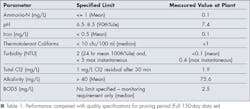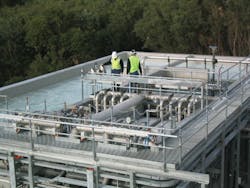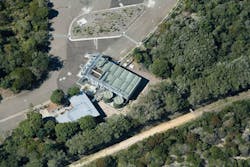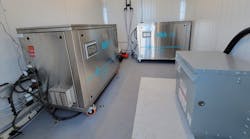The North Head Recycled Water Plant's modular design will enable Sydney Water Corporation to increase current capacity from two million liters per day (ML/d) to an ultimate capacity of nine ML/d by constructing additional bioreactors within the limited available footprint. The plant has saved up to 1.5 ML/d or 550 ML/y of drinking water since its 2005 commissioning.
Ian Gabriel, Loke Wong, Roger Phelps
The North Head Sewage Treatment Plant discharges approximately 330 million liters per day (ML/d) of primary treated effluent via a deep ocean outfall. Located in Sydney, New South Wales, Australia, the plant is the second-largest sewage treatment plant owned and operated by Sydney Water Corporation.
In 2003, continued drought and mandatory water restrictions led the company to explore alternatives to using potable water as process water. After an open tendering process, CHJY Freshwater was awarded a contract to build a two ML/d high-quality recycled water plant. Water from the plant could be used for cooling, spray water, seal water, washdown water, polyelectrolyte batching, and odor scrubber makeup water. CHJY is a joint venture between CH2M Hill Australia Pty Ltd. and John Young (Kelvinhaugh) Pty Ltd.
In constructing the new recycled water plant, Sydney Water and CHJY had to consider many environmental factors. For instance, the plant, which is surrounded by a national park near Manly Beach, could not affect the local community or tourism. It also had to fit on a small parcel of land and not threaten the habitat of endangered flora and fauna.
Plant construction was largely completed in six months. Dry and wet commissioning of equipment and instruments culminated with the seed sludge commissioning in early August 2005 – just nine months after the project began. After stabilizing biomass in the bioreactor and ensuring that the required effluent quality requirements were being met, the plant passed a three-day acceptance test at the end of September. The recycled water was then diverted to an existing storage tank for use at the North Head Sewage Treatment Plant. The plant then entered a strict 150-day performance process proving period that concluded on January 30, 2006, by the end of which the facility had met all design and output parameters. Assets were handed over to Sydney Water at this time.
MBR solution
After analyzing various technologies that could meet the plant’s performance criteria, CHJY selected a membrane bioreactor (MBR) system from South Windsor-based Siemens Water Technologies. Small footprint, high-quality effluent, low chemical usage, low sludge volume and price all factored into CHJY’s decision. The MBR system consists of two trains of Memcor® membranes and contains a total of 320 modules.
In the MBR system, wastewater is screened before entering the biological treatment tank. Aeration within this aerobic reactor zone provides oxygen for the biological respiration and maintains solids in suspension. To retain the active biomass in the process, the MBR relies on submerged membranes as a barrier rather than clarifiers, eliminating sludge settleability as an issue. This allows the biological process to operate at long sludge ages (typically 10 to 100 days) and increased mixed liquor suspended solids (MLSS) concentrations (typically 8,000 to 11,000 mg/L).
High MLSS concentrations and long solids retention time promote numerous process benefits including stable operation, complete nitrification, and reduced biosolids production. High MLSS concentrations also reduce biological volume requirements (and associated footprint) to only 20% to 30% of conventional biological processes. Further, the membranes provide extremely space-efficient solids separation and do not require a clarifier in the system.
The submerged membranes are located in a separated membrane tank and consist of polymeric hollow fibers. These hollow fibers are bound together into modules using a unique dual-potting system. By applying a low vacuum to the inside of the hollow fibers, the fully oxidized and nitrified water is filtered through the membranes. Meanwhile, mixed liquor and air are pumped continuously across each membrane module fiber bundle. The resulting two-phase cross-flow constantly scours the membrane surface, preventing solids buildup and membrane fouling.
A hypochlorite semi-automated clean-in-place (CIP) operation removes organics from the MBR’s membranes in four to six hours; a full dual CIP (hypo/citric) removes organics/inorganics from the membranes in 12 hours. This allows plant operators to perform cleanings during low demand periods. The Siemens separated membrane process design allows the membranes to be totally isolated from the biological process and protects sensitive biology from chemicals such as chlorine or acid. Cleaning takes place without having to lift or remove the membrane module, disconnect pipes and fittings, or use high-pressure hoses that may damage the membranes. Designed primarily as a hands-off process, the simple and efficient semi-automatic CIP operation is safe and convenient for operators. At the North Head plant, CIP is done once every three months.
In addition, a fully automated maintenance clean with low concentrations of hypochlorite is carried out once a week to maintain operation of the membranes.
Overall process flow
The MBR system is integral to Sydney Water’s overall biological train. Here, screened settled sewage is first pumped into the anoxic zone. Mixed liquor return from the membrane operating system also enters the anoxic zone after passing through a small de-aeration zone.
The combined screened settled sewage and mixed liquor return flows are then mixed under anoxic conditions. Appropriate residence time is allowed for partial denitrification of the mixed liquor return to take place. Mixed liquor flow from the anoxic zone then passes through to the first and second aerobic zones, allowing nitrification to occur. After an appropriate residence time, the mixed liquor is pumped from the end of the second aerobic zone into the membrane operating system where it is combined with the module aeration flow.
Filtrate pumps draw clear filtrate through the membranes by applying a suction. The remainder of the mixed liquor that is pumped to the membrane operating system then overflows a weir and returns to the anoxic zone.
Sydney Water incorporated equipment redundancy into the MBR system, such as blowers, pumps and other critical pieces of equipment. The dual membrane trains provide the flexibility to take one train out for maintenance while keeping the other train in operation.
1.5 ML/d saved
Although the North Head Recycled Water Plant’s current capacity is two ML/d, it has a modular design that allows for an ultimate capacity of nine ML/d by constructing additional bioreactors within the limited available footprint. Since its 2005 commissioning, the plant has saved up to 1.5 ML/d or 550 ML/y of drinking water.
Recycled water may eventually be piped outside the sewage treatment plant boundaries for other uses. Sydney Water is currently working with Manly Council to further examine and confirm the viability of supplying recycled water for various irrigation water users in the Manly area.
During the proving period, the plant showed overall compliance with the specified effluent quality criteria, especially for ammonia, thermotolerant coliforms and turbidity, which proved better than the specified requirements (Table 1). Gavin Landers, senior production officer at the North Head facility, reported that the MBR system continues to work well with similar results to those in Table 1. Filtrate quality has an average online turbidity of 0.02 NTU and, after 12 months of service, operating pressures indicate that membrane fouling is minimal.
Landers also estimated that since the plant’s commissioning, the whole plant, excluding the feed pump station, uses approximately 660 kWh/ML treated. The plant is most efficient in terms of “energy consumption per ML” when operating at its full capacity (two ML/d). The amount of air required for membrane agitation at the membrane operating system unit is fixed, while that for the biological process depends on plant loading.
Sydney Water has 30 other sewage treatment plants that serve the Sydney, Illawarra and Blue Mountain regions. Across greater Sydney, 14 large-scale schemes recycle around 15 billion liters of wastewater a year for home use, irrigation, agriculture and industry, including Sydney Water's own sewage treatment plant operations. By 2015, recycling will increase to 70 billion liters a year - more than a quadruple increase.
Authors’ Note
Ian Gabriel, BSc (Hons) – Industrial Chemistry and MEngSc – Water and Wastewater Treatment, is a plant manager with the Sydney Water Corporation in Sydney, New South Wales, Australia. He can be reached at [email protected]. Loke Wong, MIEAust, CPEng, is a project manager, and Roger Phelps, a senior development engineer, for Siemens Water Technologies. Both are located in South Windsor, NSW. Loke can be reached at [email protected] and Roger can be contacted at [email protected].






